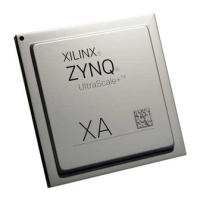RFSoC Data Converter Evaluation Tool User Guide 49
UG1287 (v2018.2) October 1, 2018 www.xilinx.com
Chapter 7: Protocol Specification
Socket Interface
The TCP/IP socket protocol is used for the datapath and control path. The LabVIEW GUI
running on the host machine has TCP clients, and the TCP servers are running under the
Linux application on the RFSoC PS. The control path works on TCP port 8081 and datapath
works on TCP port 8082. The TCP socket uses a Linux TCP/IP stack, which uses the GEM
Ethernet controller and driver for sending packets. Because the TCP socket is used, it is
possible to run the GUI on any networked machines.
Control Path
The control interface is a generic command-response interface that can be used to call any
software API or function. Its main purpose is to provide a robust communication method
between a host and client application that allows RFDC hardware control commands to be
issued and responses to be retrieved. All control commands are sent over TCP port 8081. At
a high-level, it is string-based—meaning when supporting a new hardware interface, all that
is required is the ability to send and receive terminated strings over that interface, and the
core code remains unchanged.
Control Path State Machine
The control path is used to control and configure the RF-ADCs, RF-DACs, or board
peripherals. It uses the I2C client driver or RFDC driver to configure peripherals. Figure 7-2
shows the Control/Command state machine.
X-Ref Target - Figure 7-2
Figure 7-2: Control/Command State Machine
Get
Command
Execute
Parse
Command
Error Return
X21256-090918

